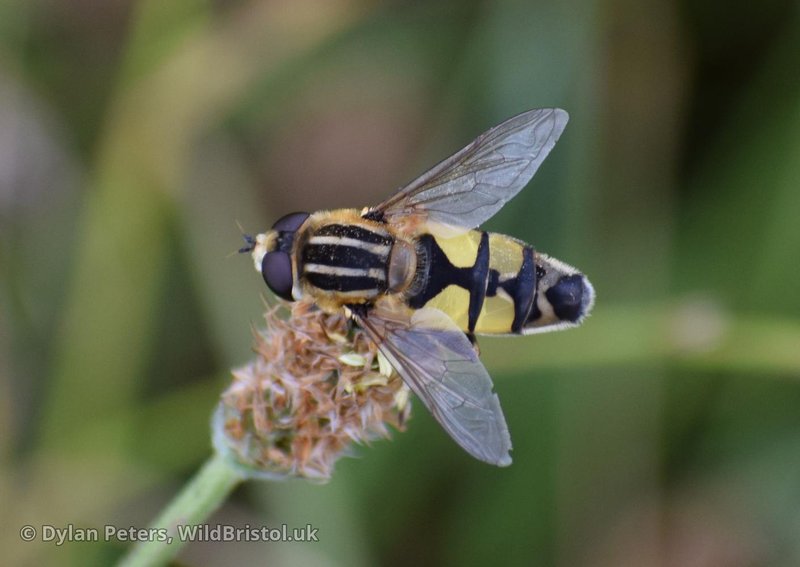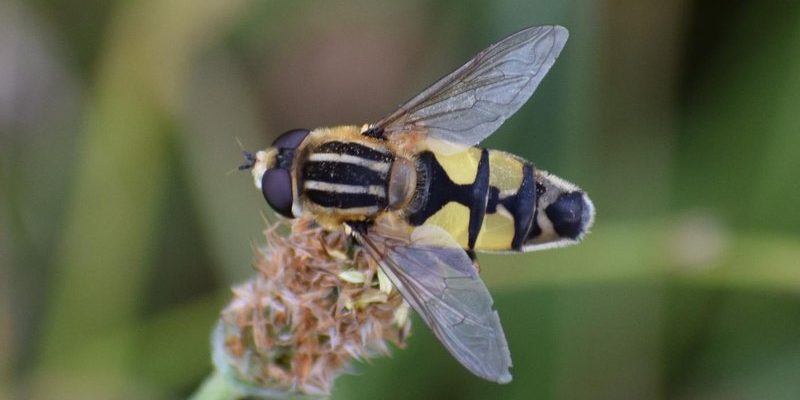
Have you ever noticed a small, buzzing insect hovering around your garden, looking almost like a tiny helicopter? That’s likely a hoverfly, a fascinating creature often mistaken for a bee or wasp due to its similar appearance. These delightful insects are not only cute but play a crucial role in our ecosystem. They are essential pollinators, helping to fertilize flowers and produce fruits and vegetables. But there’s so much more to them than meets the eye!
Hoverflies belong to the family Syrphidae, and there are over 6,000 known species worldwide. What’s remarkable is their ability to hover in place, which gives them their name. They can also perform impressive aerial maneuvers, making them look like they are dancing in the air. If you’re as curious as I am about these little flying wonders, let’s dive deeper into their world!
What Are Hoverflies?
Hoverflies, also known as syrphid flies, are small, often brightly colored insects that are easily recognized by their unique flying ability. They typically range in size from 6 to 20 millimeters long. While many species exhibit a striking similarity to wasps and bees—complete with yellow and black stripes—hoverflies are harmless. They don’t sting, and their presence in your garden is generally beneficial.
Aside from their looks, hoverflies have a fascinating way of adapting to their environments. They can be found in a wide variety of habitats, ranging from gardens and forests to wetlands and meadows. Their flexibility makes them not only resilient but also vital for different ecosystems. They thrive in areas rich in flowers, where they can feed on nectar and pollen.
Life Cycle of Hoverflies
The life cycle of hoverflies consists of four main stages: egg, larva, pupa, and adult. The adult female hoverfly lays her eggs near or on plants that provide food for the larvae, usually aphids or other soft-bodied insects. After a few days, the eggs hatch into larvae, which are voracious eaters, helping to control pest populations naturally.
As the larvae grow, they undergo several molts, eventually reaching the pupal stage. The pupae are usually found in a safe place among leaf litter or soil. During this time, they undergo a remarkable transformation. Adult hoverflies emerge from the pupae after a couple of weeks, ready to continue the cycle. This entire process can vary in length depending on environmental factors, but most hoverflies complete their life cycle in a few weeks to a few months.
| Fact | Details |
|---|---|
| Size: | 6 to 20 millimeters long |
| Habitat: | Gardens, forests, wetlands, meadows |
| Diet: | Nectar and pollen as adults; aphids as larvae |
| Flight Speed: | Can hover in place and fly backward with agility |
| Lifespan: | Several weeks to a few months |
Benefits of Hoverflies
You might be wondering why hoverflies are essential to our ecosystem. One major benefit is their role as pollinators. While they may not be as famous as bees, hoverflies contribute significantly to pollinating flowers. As they feed on nectar, they transfer pollen from one flower to another, promoting the growth of fruits and seeds. In fact, hoverflies are particularly good at pollinating crops because they are attracted to a wide variety of flowering plants.
Another crucial benefit of hoverflies is their appetite for pests. Their larvae are incredibly effective at controlling aphid populations, which are common garden pests. This natural pest control helps reduce the need for chemical pesticides, making hoverflies not only a friend to gardeners but also a boon for organic farming.
Hoverfly Species Diversity
The Syrphidae family includes a vast array of hoverfly species, each with unique characteristics. For example, the European Marmalade Hoverfly (Episyrphus balteatus) is easily recognized by its orange and black striped body. This hoverfly is known for migrating vast distances, which can impact various ecosystems across regions.
Another interesting species is the Drone Fly (Eristalis tenax), which resembles a honeybee. It’s often found in gardens and is known to hover around flowers to collect nectar. Each species of hoverfly has adapted to specific environments and food sources, showcasing nature’s diversity beautifully.
Common Misconceptions About Hoverflies
Even though hoverflies look similar to bees, many people are unaware that they do not sting. This misconception often leads to unnecessary fear and swatting at these friendly insects. Understanding that hoverflies are non-aggressive and play a vital role in gardening can help create a friendlier atmosphere for these helpful creatures.
Another common misunderstanding is that hoverflies are dangerous pests. In reality, they are beneficial insects that support plant health and reduce pest populations. By encouraging hoverflies to visit your garden, you’re not just helping pollinate flowers, but also keeping pesky aphids at bay!
Where to Find Hoverflies
Finding hoverflies is easier than you might think! They are attracted to flowering plants, especially daisies, sunflowers, and herbs like dill, fennel, and coriander. Planting a diverse range of flowers can create a hoverfly haven in your backyard. Look for them on warm, sunny days when they are most active.
If you want to spot these insects in the wild, visiting nature reserves or botanical gardens rich in flowers during spring and summer is your best bet. Hoverflies are highly active during these times, darting around and hovering near blooms, making them easier to observe.
Hoverflies and the Environment
Hoverflies are an essential part of our ecosystem. Their role as both pollinators and pest controllers makes them invaluable to natural habitats and agricultural systems. Increasing hoverfly populations can lead to healthier ecosystems, which can improve biodiversity.
As we face environmental challenges, such as habitat loss and pesticide use, championing hoverflies can support ecological balance. Creating a garden that welcomes these insects can contribute positively to their populations and, in turn, support the overall health of our planet.
How to Attract Hoverflies to Your Garden
Attracting hoverflies to your garden is a fun and rewarding endeavor. Start by planting a variety of flowers that bloom at different times throughout the growing season. This ensures a continuous supply of nectar and pollen. Good options include marigolds, zinnias, and herbs like mint and basil.
Another effective way to draw hoverflies in is by reducing pesticide use. Chemicals can harm not only hoverflies but also other helpful insects. Instead, consider more natural pest control methods, like companion planting or introducing beneficial insects to your garden. With a flourishing environment, hoverflies will be more likely to thrive.
Hoverfly Research and Conservation
Research on hoverflies is ongoing, as scientists continue to uncover the vast diversity and ecological importance of these insects. Studies aim to understand their behaviors, migration patterns, and how environmental changes impact their populations. Increased awareness and education about hoverflies can help foster a culture of conservation around these vital insects.
In many regions, conservation efforts are aimed at preserving native flora that supports hoverfly populations. Educating communities about the benefits of hoverflies can also help promote practices that protect these insects and their habitats from degradation.
FAQ
What do hoverflies eat?
Hoverflies primarily feed on nectar and pollen as adults. They are particularly drawn to flowers that produce abundant nectar, which is crucial for their energy needs. As larvae, they have a different diet, mainly consuming soft-bodied pests like aphids. This dual diet allows them to thrive at various life stages while playing roles in both pollination and pest control.
Are hoverflies dangerous?
No, hoverflies are not dangerous. They do not sting, making them harmless to humans and pets. People often mistake them for bees or wasps due to their similar appearance, but hovering flies are gentle insects that contribute positively to gardens by pollinating flowers and controlling pest populations.
How can I tell hoverflies apart from bees and wasps?
Hoverflies can be distinguished from bees and wasps by their body shape and flying behavior. They have a more slender, elongated body and are often seen hovering in one spot, giving them their name. Also, hoverflies have large, distinctive eyes that almost touch, which is different from bees and wasps. If you pay attention to their flying patterns, you will notice hoverflies can hover mid-air, unlike bees that typically buzz from flower to flower.
Can hoverflies be found all year round?
Hoverfly activity depends largely on the climate. In temperate regions, hoverflies are mainly active during warm months, typically from spring to autumn. Some species may enter a dormant stage during colder months, while others will migrate to warmer areas. In tropical climates, hoverflies can be found year-round due to the consistent availability of flowers and food sources.
Do hoverflies have any natural predators?
Yes, hoverflies do have natural predators. Birds, spiders, and some predatory insects may prey on hoverflies, particularly the larvae. However, adult hoverflies have developed various defenses. Their coloration can mimic bees and wasps, deterring potential predators that may assume they can sting. Furthermore, their ability to dart quickly and hover provides them an advantage in escaping dangers.
Are hoverflies affected by climate change?
Like many other insects, hoverflies are likely affected by climate change. Changes in temperature and weather patterns can disrupt their life cycles and food availability. Warmer temperatures may encourage hoverflies to emerge earlier in the season, but it can also lead to mismatches with the timing of flower blooms. Ongoing research aims to understand the extent of climate change’s impacts on their populations and behaviors.
What can I do to promote hoverfly populations in my garden?
Promoting hoverfly populations in your garden is a rewarding endeavor. Start by planting a diverse array of flowers that bloom at different times throughout the growing season. Additionally, reduce or eliminate pesticide use that can harm these beneficial insects. Creating a natural habitat with native plants and maintaining a healthy ecosystem will encourage hoverflies to thrive.
How long do hoverflies live?
The lifespan of hoverflies can vary significantly by species and environmental conditions. Generally, hoverflies live several weeks to a few months. Their life cycle, including the egg, larval, pupal, and adult stages, can be completed in a matter of weeks, depending on factors like temperature and food availability. Adult hoverflies typically live long enough to reproduce, ensuring the continuation of their species.
Can hoverflies help with my garden’s health?
Absolutely! Hoverflies are excellent for your garden’s health. As pollinators, they assist in fertilizing your flowers, which leads to fruit and seed production. Additionally, their larvae are natural predators of aphids and other garden pests, reducing the need for chemical pesticides. Encouraging hoverflies to visit your garden can lead to a more vibrant and productive gardening experience.
What types of hoverflies are common in North America?
North America hosts a variety of hoverfly species. Some common ones include the Flower Fly (Syrphus ribesii) and the American Hoverfly (Eristalis tenax). Each species has distinct characteristics, but they all share the hoverfly’s beneficial traits of pollinating flowers and controlling pest populations. Observing these species in your garden can be both educational and enjoyable!

